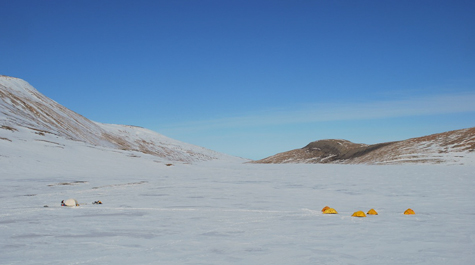PNAS paper: Climate-driving Atlantic sea-surface temps are the warmest they’ve been for 3 millennia
South Sawtooth Lake on Canada’s Ellsmere Island is deep, cold and filled with answers for climate-change scientists.
This lake at 80 degrees north has been collecting sediment for millennia —but it doesn’t collect sediment all year.
“In most years, this lake is covered with ice nine to ten months out of the year,” said William & Mary geologist Nick Balascio. “And not just a little skim of ice, but two-plus meters of lake ice.”
Balascio was designated a “Rising Star” among Virginia professors receiving the 2020 Outstanding Faculty Award, honors announced each year by the State Council of Higher Education. He is one of a group of scientists who have been taking advantage of a phenomenon connected to the short Ellsmere Island summer, which sees a strong, sudden pulse of sediment into the lake from snowmelt. By coring deep into the bottom, the researchers bring up columns of varves — laminated layers of sediment.
Each varve represents a year of sedimentation dominated by a summer “pulse of sediment” Balascio said. And analysis of one of those preserved sediment layers can reveal information about past seasonal temperatures. In this study, the team correlated their record of temperature variations at Sawtooth Lake to condition in the North Atlantic Ocean.
Balascio and his colleagues have logged nearly three millennia of sea surface temperatures, an important set of observations for 21st century people dealing with the effects of climate change. They’ve presented their findings in a paper “Annually resolved Atlantic sea surface temperature variability over the past 2,900 y” recently published in the Proceedings of the National Academy of Sciences (PNAS).
“Any influence we, as humans, have on the climate system is going to be superimposed on whatever variations naturally exist,” explained Balascio, an assistant professor in William & Mary’s Department of Geology. “And these variations exist due to a variety of factors, one of which is the natural variability of ocean surface temperatures.”
The work summarized in the PNAS paper tracks a climactic phenomenon known as Atlantic multidecadal variability, or AMV. The AMV, the paper explains, tracks the long-term variability of North Atlantic sea surface temperatures. Humans have been measuring the sea temperature for around 160 years, a blink of the eye in geological terms.
But geologists have figured out how to determine temperatures long past by reading the varves much as dendochronologists read tree rings. Years of colder North Atlantic water result in heavier snowpack in the South Sawtooth watershed, and when the summer melt comes, more sediment goes into the lake, sinking to the bottom and eventually forming that year’s varve.
“And during the years where there are warmer temperatures, there is less of a snowpack to move material into the lake,” Balascio said. “So, there is a connection between those temperatures and the delivery of sediment into that basin.”
What’s important is that the AMV cycles are a major driver of climate in the Northern Hemisphere, especially in the Arctic, where the effects of a warming Earth are among the most pronounced and dramatic. Balascio and his colleagues report in their paper that the sea surface temperatures are now at the warmest they’ve been for a long time — 2,900 years, in fact.
They report a long cooling trend beginning around 900 A.D. and leading to the coolest period of the last three millennia, which occurred between 1400 and 1605. Temperatures started to rise in the late 16th century, a rise that also saw an increase in the AMV, that driver of Northern Hemisphere climate.
Of course, anthropogenic warming has a cumulative effect and continues to be a contributor to the warming trend of sea surface temperatures on top of the natural variability — but how much? Balascio said that the deeper understanding of the prehistoric AMV will help researchers untangle such questions.
“Being able to understand the system — how these temperatures vary over longer time periods — is important to defining natural climate variability,” he said. “And it’s important because these changes in temperature have far-felt impacts. They influence climate of the Arctic as well as the Northern Hemisphere more broadly.”















